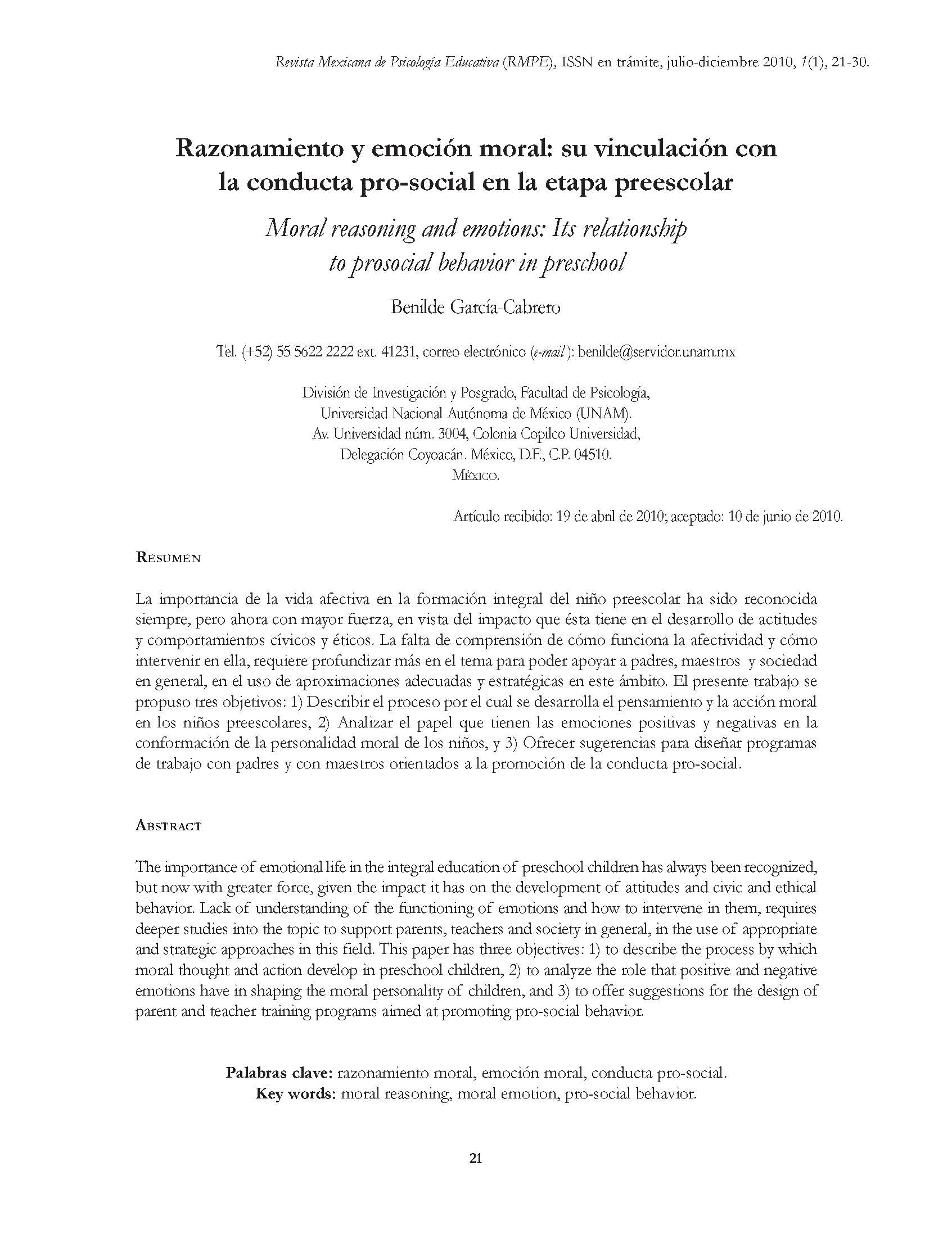Abstract
The importance of emotional life in the integral education of preschool children has always been recognized, but now with greater force, given the impact it has on the development of attitudes and civic and ethical behavior. Lack of understanding of the functioning of emotions and how to intervene in them, requires deeper studies into the topic to support parents, teachers and society in general, in the use of appropriate and strategic approaches in this field. This paper has three objectives: 1) to describe the process by which moral thought and action develop in preschool children, 2) to analyze the role that positive and negative emotions have in shaping the moral personality of children, and 3) to offer suggestions for the design of parent and teacher training programs aimed at promoting pro-social behavior.
References
Araujo, V. A. y Sastre, V. G. (2003). Moralidad, senti- mientos, y educación. Educar, 31, 47-66.
Arsenio, W. (1988). Children’s conceptions of the situational affective consequences of victimization. Child Development, 59, 1611-1622.
Borke, H. (1971). Interpersonal perception of young children: egocentrism or empathy? Developmental Psychology, 38, 469-479.
Bronson, M. B. (2000). Self-regulation in early childhood.
Nueva York: Guilford Press.
Colby, A., Ehrlich, T., Beaumont, E. y Stephen, J. (2003). Educating citizens: Preparing america's underg- raduates for lives of moral and civic responsibility. San Francisco: Jossey-Bass.
Dunn, J. (1987). The beginnings of moral understanding: Developments in the second year. En J. Kagan y S. Lamb (Eds.), The emergence of morality (pp. 91-112). Chicago: University of Chicago Press.
Edelstein, W. (2005). The rise of right-wing extremist youth culture un post-unification Germany. En:
L. Nucci (Ed.), Conflict, contradiction, and contrarian elements in moral development and education (pp. 157- 172). Mahwah, Nueva Jersey: Lawrence Erlbaum Associates Publishers.
Emde, R., Johnson, W.F. y Easterbrooks, M.A. (1987).The Do’s and Don’ts of early moral devel- opment: Psychoanalytic tradition and current research. En J. Kagan, y S. Lamb (Eds.), The emergence of morality in young children (pp. 245-276). Chicago: University of Chicago Press.
García-Cabrero, B. y Eguía, S. (2006). El razonamiento y la afectividad moral: componentes esenciales de la educación moral y cívica. Revista Educación 2001, 132, 37-45.
García-Cabrero, B. y Flores, R. C. (1998). El desarrollo de programas de vinculación escuela-hogar. Integración: Educación y Desarrollo Psicológico, 10, 36-50.
Gardner, H. (2001). Inteligencias múltiples (La teoría en la práctica). Barcelona: Paidós.
Gelman, R. (1979). Preschool thought. American Psychologist, 34, 900-905.
Haidt, J. (2003). The moral emotions. En R. J. Davidson, K. R. Scherer y H. H. Goldsmith (Eds.), Handbook of affective sciences (pp. 852-870). Oxford: Oxford University Press.
Hoffman, M. L. (1987). The contribution of empathy to justice and moral judgment. En N. Eisenberg y
J. Strayer (Eds.), Empathy and its development. New York: Cambridge University Press.
Hong, Y. (2003). An Ethnographic Study of Korean Kindergartners' Reasoning During Group Moral Discussions. Early Childhood Education Journal, 30(3), 151-156.
Jagers, R. J. (2005). Moral competence promotion among African American children: conceptual under- pinnings and programmatic efforts. En: L. Nucci (Ed.), Conflict, contradiction and contrarian elements in moral development and education (193-212). Mahwah, New Jersey: Lawrence Erlabaum Associates Publishers. Kagan, J. (1981). The second year. The emergency for self- awareness. Cambridge, MA: Harvard University
Press.
Kohlberg, L. (1992). Psicología del desarrollo moral. Bilbao: Desclée de Brouwer.
Nucci, L. (2001). Education in the moral domain.
Cambridge: Cambridge University Press.
Onn, J. (1998). Civics and moral education in Singapore: Lessons for citizenship education?, Journal of Moral Education, 27(4), 505-524.
Oser, F. K. (2005). Negative morality and the goals of moral education. En L. Nucci (Ed.), Conflict, contradiction, and contrarian elements in moral development and education (pp. 129-153). Mahwah, Nueva Jersey: Lawrence Erlbaum Associates Publishers.
Oser, F. K. y Veugelers, W. (2003). Teaching in moral and democratic education. Bern: Peter Lang.
Perner, J. (1991). Understanding the representational mind.
Cambridge, MA: MIT Press.
Piaget, J. (1932). The moral judgment of the child. Londres: Rout- ledge. Traducido al español (1977) por Ed. Fontanella, Barcelona bajo el título: El criterio moral del niño.
Piaget, J. (1981). Intelligence and affectivity: their relationship during child development. Palo Alto, California: Annual Reviews. Puig, J. M. (1995). La educación moral en la enseñanza obligatoria. Cuadernos de Educación, Número 17. Barcelona: Horsori.
Puig, J. M. (1996). La construcción de la personalidad moral.
Barcelona: Paidós.
Scheler, M. (1996). Ordo amoris. Madrid: Caparrós.
SEP (2004). Programa de Educación Preescolar. México: SEP. Disponible en: http://www.oei.es/ inicial/curriculum/programa2004_mexico.pdf
Sy, S. R., DeMeis, D. K. y Scheinfield, R. E. (2003). Pre- school children’s understanding of the emotional consequences for failures to act prosocially. British Journal of Developmental Psychology, 21, 259-272.
Walsh, J. D. (1992). Implications of a post-Piagetian perspective for early childhood education: Helping children make sense. Ponencia invitada al Taipei Municipal Early Childhood Education. Taipei, China

This work is licensed under a Creative Commons Attribution-NonCommercial-NoDerivatives 4.0 International License.
Copyright (c) 2024 Universidad Nacional Autónoma de México


